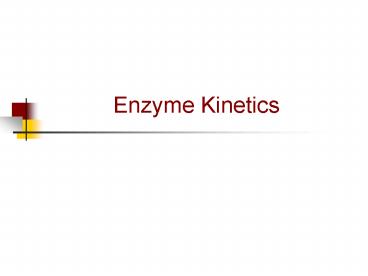Enzyme Kinetics PowerPoint PPT Presentation
1 / 40
Title: Enzyme Kinetics
1
Enzyme Kinetics
2
Enzyme Kinetics
- Kinetics is the study of the rate and mechanism
of a reaction. - Rates are usually measured in terms of how many
moles of reactant or product are changed per time
period. - A mechanism is a detailed step-by-step
description of how a reaction occurs at the
molecular level.
3
Determining Initial Velocity (Vo)
4
Michaelis-Menten Plot
5
What are Vmax and KM?
6
Vmax and KM
- Vmax is limited by
- Time required for product to be released
- How many E molecules are present
- KM gives an idea about affinity
- ?KM ?substrate affinity
- ?KM ?substrate affinity
7
Determining KM and Vmax
Lineweaver-Burk (Double Reciprocal Plot)
o
8
Enzyme Inhibition
- Inhibitors
- Many substances like drugs, toxins reduce or stop
reaction rate of enzymes - Important control mechanism in cells
- Responsible for down regulation in physiological
processes - Irreversible
- Covalent bonding of inhibitor with enzyme
- Reversible
- Competitive
- Noncompetitive
9
Irreversible Inhibitors
- Group specific agents
- React with specific amino acid R groups
- Penicillin
- Inhibitor of serine-containing enzymes
- Acetylcholinesterase
- Organophosphates cause paralysis
http//www.tvacres.com/images/bug_raid2.jpg
Organophosphate insecticides inhibit
acetylcholinesterase.
10
Reversible Inhibition Competitive Inhibitors
- Inhibitor resembles substrate and binds at active
site. - Can overcome by adding additional substrate.
11
Competitive Inhibitor
- Increases KM
- (? enzymes apparent affinity for substrate)
- Does not affect Vmax
12
Competitive Inhibitor Example
- Ethanol for antifreeze poisoning
- Competitive inhibitor of alcohol dehydrogenase
http//www.prestone.com/products/antifreezeCoolant
.php
13
Reversible Inhibition Noncompetitive Inhibitors
- Inhibitor binds at site other than active site.
- Cannot overcome by adding extra substrate.
http//www.steve.gb.com/science/enzymes.html
14
Noncompetitive Inhibitor
- Decreases Vmax
- (? apparent E)
- Does not affect KM
http//ccnmtl.columbia.edu/projects/biology/lectur
e7/lec7_01.htm
Inhibitor substrate
1/v
substrate
1/S
15
Review of Reversible Inhibitors
http//users.rcn.com/jkimball.ma.ultranet/BiologyP
ages/E/EnzymeKinetics.html
16
Problem
- The enzyme O-diphenol oxidase causes apple slice
to turn brown in presence of air. - What type of inhibtor is PHBA (para-hydroxy
benzoic acid)? - What type of inhibitor is phenylthiourea?
http//users.rcn.com/jkimball.ma.ultranet/BiologyP
ages/E/EnzymeKinetics.html
17
Enzyme Regulation
- Methods used by cell to regulate rate of
reactions - S, P (substrate level regulation)
- pH, salt (various ions)
- Inhibitors (presence and concentration)
- Allosteric modification
- Covalent modification
18
Allosteric Enzymes
- Do not exhibit Michaelis-Menten kinetics.
- Plot of Vo vs. S is sigmoidal not hyperbolic.
Why?
S
19
Allosteric Enzymes
Relaxed (R) state (? Km)
- Generally are multisubunit enzymes.
- Exhibit cooperativity.
- The binding of substrate to one active site
changes the 3-D conformation, which alters the
affinity other subunits have for the substrate.
Tense (T) state (? Km)
20
One Model of Allosteric Mechanism
- The binding of substrate switches conformation of
only the subunit to which it is bound. - Conformational change in one subunit may ? or ?
the affinity of other subunits have for the
substrate. - Allows for or - cooperativity.
21
Allosteric Enzyme RegulationFeedback Inhibition
- A ? B ? C ? D ? P
- E1 E2 E3 E4
Inhibition
Threonine deaminase is regulated by isoleucine
in the cell. Enzyme exists as 2
states Isoleucine acts as allosteric
effector and binds to enzyme at allosteric site.
Allosteric inhibitor or activator.
22
Allosteric Inhibition Activation
23
Allosteric Regulation
effector
no effector
- effector
24
Types of Subunits
- Catalytic subunits (C)
- Where active sites are located.
- Substrate binds here.
- Regulatory subunits (R)
- Effectors bind here.
25
Aspartate Transcarbamoylase (ATCase) Structure
- Important in pyrimidine biosynthesis
- r6c6
- 3 regulatory subunits (consisting of 2 chains
each) - 2 catalytic subunits (consisting of 3 chains each)
c
c
c
r
r
r
r
r
r
c
c
c
26
ATCase Inhibition
27
ATCase Regulation
ATP
no effector
- CTP
28
Oxygen Transport Proteins
- Myoglobin
- Exhibits Michaelis-Menten properties
- Hemoglobin
- Exhibits allosteric properties
29
Myoglobin
- Single polypeptide
- 16,700 daltons
- 8 a helices (A-H)
- Located in skeletal cardiac muscle
- high in diving mammals like whale seals
Heme prosthetic group
http//www.agen.ufl.edu/chyn/age2062/lect/lect_02
/3_27.gif
30
Myoglobin O2 Binding Curve
- Myoglobin has high affinity for O2.
- P50 2.8 Torr
- Allows myoglobin to act as O2 storage reserve.
- Releases O2 when pO2 becomes low indicating O2
deprivation.
31
Hemoglobin
- Heterotetramer
- HbA (95-98 of adults)
- a2b2
- HbA2 (lt3 of Hb)
- a2?2
- HbF (Fetal Hb, 2 of adults)
- a2?2
- 2 dimers
32
Hemoglobin Structure
- Each polypeptide chain resembles myoglobin
tertiary structure but 1 sequence varies. - Hb exhibits cooperativity
33
Hb Variants
- HbA2
- a2d2
- Present in 2 of adults
- Embryonic Hb
- a2e2
- Has ? affinity for O2
- Fetal Hb
- a2g2
- Has ? affinity for O2
http//oregonstate.edu/instruction/bb450/stryer/ch
10/Slide27.jpg
34
Regulation Via Protein Modification
- Covalent modification
- Phosphorylation
- Acetylation
- ADP-ribosylation
- Proteolytic Cleavage
35
Regulation by Phosphorylation
36
Glycogen Metabolism
- Two opposing pathways operating
- Synthesis of glycogen
- Breakdown of glycogen
- Do we want both pathways operating
simultaneously?
NO!
37
Glycogen Synthesis
ATP
ADP
GS kinase
Glycogen synthase inactive
Glycogen synthase active
Pi
HO
phosphatase
Pi
H2O
38
Glycogen Degradation
39
Proteolytic Cleavage
- Proenzyme or zymogen is an inactive form of
enzyme. - Cleavage of zymogen produces active enzyme.
Becker, W. M., L. J. Kleinsmith, and J. Hardin.
(2002) The World of the Cell, 5th ed. Benjamin
Cummings, San Fransico, CA. p. 151.
40
Blood Clotting
Campbell, N.A. and J. B. Reece. (2005) Biology,
7th ed. Benjamin Cummings, San Francisco, CA, p.
882

